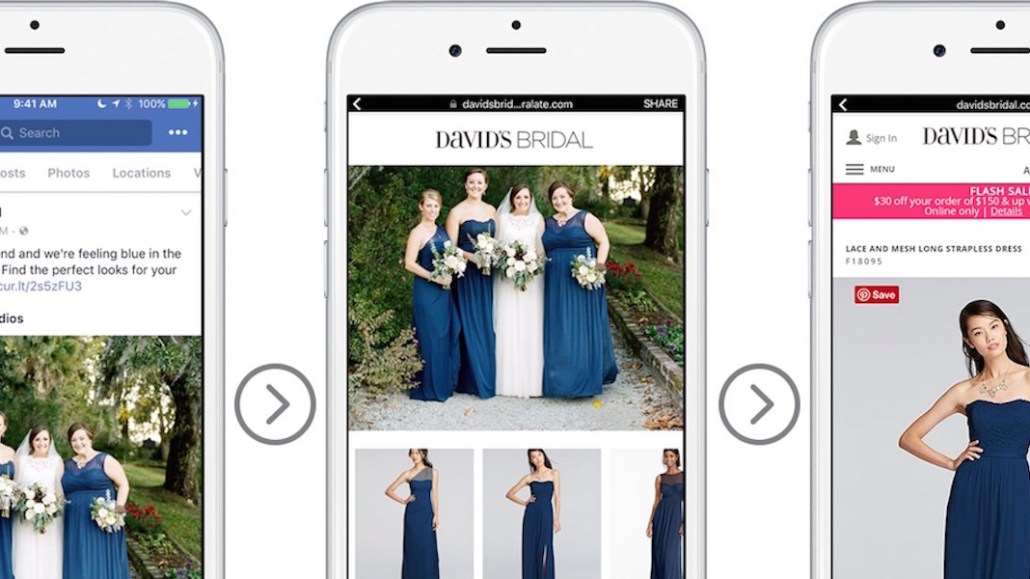

At David’s Bridal, senior director of global marketing Callie Canfield faced a pressing problem when trying to drive people from the brand’s social channels to its online store. When the brand would post an image of new bridesmaid dresses to its Facebook or Instagram, for instance, customers who clicked on it would be dumped into the full online catalog for the bridesmaid dress category. Finding the styles they saw in the Facebook photo would require sifting through hundreds of dresses.
“We want the customer to click through from Facebook or another social channel to our site, and get to a landing page that shows exactly what they clicked on,” said Canfield. “But it’s almost impossible to customize your site that way — it would take a major backend overhaul, and we’re a big, pretty slow-moving company.”
To solve this, David’s Bridal has been working with visual commerce platform Curalate in the beta stage of its new Showroom feature, a tool that uses artificial intelligence to create pop-up landing pages for brands to link to on social media. The landing pages pull the exact items promoted on social media, as well as a collection of related items that are populated by Curalate’s algorithms.
David’s Bridal has tested the Curalate Showroom on Facebook and on its online blog, and Canfield said that in the time since, David’s Bridal has seen 13 times more click-throughs across those platforms and a 40 percent decrease in bounce rate. Other brands testing the feature, including Banana Republic, Forever 21 and Guess, saw an average decrease in bounce rate of 53 percent and a 45 percent increase in time spent on site for shoppers entering through social media.
For David’s Bridal, Curalate’s tools also offer an appealing set of independent data that isn’t owned by the platforms they’re working with. Canfield said the brand is part of the beta test for Instagram’s shopping tags feature and also uses Curalate’s Like2Buy platform, which is a third-party shoppable feed accessible to followers through the link in bio on branded Instagram accounts.
“Curalate knows what’s in the pipeline on the platform side, so they change their platform to make it beneficial for brands,” said Canfield. “For us, it’s great to have the analytics. When working with Instagram, you don’t really have a good idea about what’s working, and it’s in their interest for you to think something is performing well. It’s nice to have a set of independent analytics.”
As Instagram has made more progress in developing tools that will help brands drive conversions on the platform, companies that have popped up as intermediaries, like Curalate, have been forced to evolve. Showroom stems from the disconnect between products promoted on social and what customers ultimately are linked to.
Canfield pointed out that this problem is especially persistent in its email marketing, which typically focuses on items related to popular wedding trends. But, there was no way for the team to send customers who clicked through the email to find all the featured items in one place. Canfield said in the future, she plans to use the Showroom tool for email marketing, as well as on paid Facebook posts, where the brand needs to get the most out of the limited resources it can put into social.
For brands, selling on social media has largely resulted in forfeiting control to the platform. Curalate CEO Apu Gupta said that makes brands nervous.
“Brands have come to realize that they are seeding a lot of information to the various networks, and when customers are making transactions through channels, you worry as a brand who owns that customer,” said Gupta. “If I start seeding a lot of information about my customer to this third party, what can they do with it? Can they redirect my customer to someone else, the next highest bidder? These are real concerns.”
When working with a platform like Curalate, brands are still forfeiting some control. Curalate needs full access to a brand’s inventory in order to use artificial intelligence to place items in a social-driven showroom. But essentially, Curalate’s data can corroborate the data coming from a social channel like Facebook.
“We have partnerships with Facebook and Pinterest, and they’re really helpful at giving us insight. When we talk with them about what’s working best, we can see whether or not that’s backed up by Curalate’s analytics,” said Canfield. “They all play together.”
More in Marketing

The Disney-OpenAI deal and generative AI copyright concerns
This week’s Digiday Podcast delves into the copyright concerns and potential trademark issues surrounding brands’ use of generative AI tools, with Davis Wright Tremaine partner Rob Driscoll.

‘There’s tremendous opportunity’: NBA sponsorships lead on European expansion
David Brody, vp, global partner management group lead at the NBA, explains its pitch to sponsor brands and how expansion isn’t far off.

New partnerships, marketing fuel BNPL’s holiday surge
This holiday season, more brands deployed BNPL services with different payment options beyond the more familiar “pay-in-four” structure.








